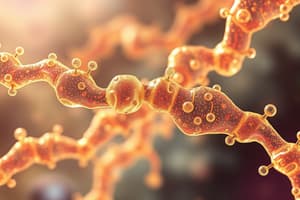Podcast
Questions and Answers
Which form of ribose is more stable compared to glucose?
Which form of ribose is more stable compared to glucose?
- α-pyranose
- α-furanose
- β-furanose (correct)
- β-pyranose
What percentage of ribose exists in the β-pyranose form?
What percentage of ribose exists in the β-pyranose form?
- 60% (correct)
- 20%
- 10%
- 25%
In which type of molecule is ribose primarily found?
In which type of molecule is ribose primarily found?
- Nucleotides (correct)
- Carbohydrates
- Lipids
- Proteins
What is the main role of ribose in RNA and DNA?
What is the main role of ribose in RNA and DNA?
Which of the following percentages represents the α-furanose form of ribose?
Which of the following percentages represents the α-furanose form of ribose?
What is the first step in converting a sugar structure from Fischer projection to Haworth projection?
What is the first step in converting a sugar structure from Fischer projection to Haworth projection?
In the Fischer projection, where should the hydroxyl groups (OH) be placed when converting to a Haworth projection?
In the Fischer projection, where should the hydroxyl groups (OH) be placed when converting to a Haworth projection?
What is the purpose of identifying the anomeric carbon in sugar structure analysis?
What is the purpose of identifying the anomeric carbon in sugar structure analysis?
When converting a sugar structure to Fischer projection, how are the positions of the hydroxyl groups indicated?
When converting a sugar structure to Fischer projection, how are the positions of the hydroxyl groups indicated?
What is a characteristic of the anomeric carbon in a monosaccharide?
What is a characteristic of the anomeric carbon in a monosaccharide?
What configuration does the n-1 carbon in Nature typically have?
What configuration does the n-1 carbon in Nature typically have?
Which statement is true regarding monosaccharides?
Which statement is true regarding monosaccharides?
What type of sugar is glucose classified as?
What type of sugar is glucose classified as?
Which feature primarily contributes to the complex stereochemistry of monosaccharides?
Which feature primarily contributes to the complex stereochemistry of monosaccharides?
Which of the following statements about D-Glucose and L-Glucose is correct?
Which of the following statements about D-Glucose and L-Glucose is correct?
What stereochemistry is associated with the n-1 carbon in Nature?
What stereochemistry is associated with the n-1 carbon in Nature?
What is the significance of the Fischer projection in regards to monosaccharides?
What is the significance of the Fischer projection in regards to monosaccharides?
How many chiral centers can a monosaccharide theoretically have?
How many chiral centers can a monosaccharide theoretically have?
Which type of projection is used to facilitate the comparison of different sugars?
Which type of projection is used to facilitate the comparison of different sugars?
Which monosaccharide is shown in its Fischer projection with the n-1 carbon having D stereochemistry?
Which monosaccharide is shown in its Fischer projection with the n-1 carbon having D stereochemistry?
Which of the following configurations represents a D monosaccharide?
Which of the following configurations represents a D monosaccharide?
What type of ring structures do monosaccharides primarily form upon cyclisation?
What type of ring structures do monosaccharides primarily form upon cyclisation?
What is the state of cyclisation of monosaccharides in solution?
What is the state of cyclisation of monosaccharides in solution?
In what form are the cyclic structures of monosaccharides most easily drawn?
In what form are the cyclic structures of monosaccharides most easily drawn?
What conformation do six-membered rings actually adopt in monosaccharides?
What conformation do six-membered rings actually adopt in monosaccharides?
What component is characteristic of the Fischer projection for monosaccharides?
What component is characteristic of the Fischer projection for monosaccharides?
What is the primary structural role of cellulose in plants?
What is the primary structural role of cellulose in plants?
Which type of glycosidic bond connects the glucose units in amylose?
Which type of glycosidic bond connects the glucose units in amylose?
How is cellulose different from amylose in terms of digestibility by humans?
How is cellulose different from amylose in terms of digestibility by humans?
What property of cellulose contributes to its role as dietary fiber?
What property of cellulose contributes to its role as dietary fiber?
Which statement accurately describes the processing of plant starches during energy generation?
Which statement accurately describes the processing of plant starches during energy generation?
Which type of linkage is present in lactose?
Which type of linkage is present in lactose?
What type of bond is primarily used for connecting monosaccharides in the formation of disaccharides?
What type of bond is primarily used for connecting monosaccharides in the formation of disaccharides?
What is the main structural difference between α-linkages and β-linkages in glycosidic bonds?
What is the main structural difference between α-linkages and β-linkages in glycosidic bonds?
Which of the following is an example of a polysaccharide that functions as an energy store?
Which of the following is an example of a polysaccharide that functions as an energy store?
Which monosaccharides are involved in the formation of sucrose?
Which monosaccharides are involved in the formation of sucrose?
What is the primary role of polysaccharides in biological systems?
What is the primary role of polysaccharides in biological systems?
Which glycosidic bond connects the C1 of one sugar to the C2 of another?
Which glycosidic bond connects the C1 of one sugar to the C2 of another?
What type of form does D-glucose primarily exist in when polymerized to form amylose?
What type of form does D-glucose primarily exist in when polymerized to form amylose?
Flashcards
Monosaccharides
Monosaccharides
Simple sugars with a formula CnH2nOn, 3-6 carbons long.
Fischer projection
Fischer projection
A way to represent the 3D structure of a molecule on a 2D plane, essential for defining chiral centers.
Stereochemistry of Monosaccharides
Stereochemistry of Monosaccharides
The 3D arrangement of atoms in a sugar molecule, crucial in determining optical isomers.
Chirality
Chirality
Signup and view all the flashcards
Aldoses
Aldoses
Signup and view all the flashcards
Ketoses
Ketoses
Signup and view all the flashcards
Carbonyl group
Carbonyl group
Signup and view all the flashcards
D-stereochemistry
D-stereochemistry
Signup and view all the flashcards
Ribose Structure
Ribose Structure
Signup and view all the flashcards
Ribose vs. Deoxyribose
Ribose vs. Deoxyribose
Signup and view all the flashcards
Ribose in Nucleotides
Ribose in Nucleotides
Signup and view all the flashcards
Ribose's Stability
Ribose's Stability
Signup and view all the flashcards
Ribose function in RNA
Ribose function in RNA
Signup and view all the flashcards
Haworth Projection
Haworth Projection
Signup and view all the flashcards
Cyclisation of Monosaccharides
Cyclisation of Monosaccharides
Signup and view all the flashcards
Pyranose form
Pyranose form
Signup and view all the flashcards
Chair Conformation
Chair Conformation
Signup and view all the flashcards
Stereochemistry of n-1 carbon
Stereochemistry of n-1 carbon
Signup and view all the flashcards
Equilibrium in solution
Equilibrium in solution
Signup and view all the flashcards
Anomeric Carbon
Anomeric Carbon
Signup and view all the flashcards
Identifying Sugars (Molecular Structure)
Identifying Sugars (Molecular Structure)
Signup and view all the flashcards
Converting linear to cyclic sugar
Converting linear to cyclic sugar
Signup and view all the flashcards
Glycosidic bond
Glycosidic bond
Signup and view all the flashcards
Disaccharide
Disaccharide
Signup and view all the flashcards
Lactose
Lactose
Signup and view all the flashcards
Sucrose
Sucrose
Signup and view all the flashcards
α-linkage
α-linkage
Signup and view all the flashcards
β-linkage
β-linkage
Signup and view all the flashcards
Polysaccharide
Polysaccharide
Signup and view all the flashcards
Amylose
Amylose
Signup and view all the flashcards
Cellulose
Cellulose
Signup and view all the flashcards
Dietary Fibre
Dietary Fibre
Signup and view all the flashcards
What makes cellulose indigestible for humans?
What makes cellulose indigestible for humans?
Signup and view all the flashcards
Study Notes
Carbohydrates
- Carbohydrates are a broad class of molecules
- Three main categories: Monosaccharides, Disaccharides, and Polysaccharides
- Monosaccharides are simple sugars; examples include glucose, fructose, and galactose
- Disaccharides are formed by joining two monosaccharides; examples include sucrose (table sugar), lactose (milk sugar), and maltose
- Polysaccharides are long chains of monosaccharides; examples include starch, glycogen, and cellulose
- Carbohydrates store energy and provide structural support in organisms
Monosaccharides
- Basic building blocks of carbohydrates
- General formula: CnH2nOn
- Simple molecules but have isomers (different structural and optical forms)
- Based around carbonyl group and several OH groups
- Difficult 3D structures, special drawing conventions are needed
- Natural forms usually have the D stereochemistry (most commonly R configuration) at carbon n-1
- Key monosaccharides include glucose, fructose, and galactose
Structure representation of Monosaccharides
- Fischer projection: Used for comparing different sugars, particularly in simplified form
- Haworth projection: Used to illustrate cyclic forms of monosaccharides; crucial for seeing important reactions
- Determining stereochemistry: Breaking the anomeric bond and rotating C6 into the ring.
Disaccharides
- Formed by joining two monosaccharides through glycosidic bonds
- Common disaccharides include sucrose, lactose, and maltose
- Glycosidic bonds can connect sugars to bases (nucleotides) and proteins / peptides (glycoproteins) and glycopeptides.
Polysaccharides
- Long chains of monosaccharides
- Important roles as energy stores and structural components
- Examples include starch (energy storage in plants), glycogen (energy storage in animals), and cellulose (structural component in plants)
- Starch (Amylose) spiral structure from several α-1,4 glycosidic bonds
- Cellulose is a straight chain polymer of glucose, with β-1,4 glycosidic bonds.
- Difficult for humans to digest, major component of dietary fibre
- Glycogen (mammals) and Amylopectin (plant starch) can also be branched.
- Chitin has similar structure to cellulose but has acetamide groups added, creating a strong polymer found in crab shells and fungal cell walls.
Carbohydrate Metabolism
- Glucose is the most abundant carbohydrate and the main source of energy
- Glycolysis is the main energy generation process
Studying That Suits You
Use AI to generate personalized quizzes and flashcards to suit your learning preferences.




